SEO, a Swiss Story & the Rolling Ball of Hay
Many of us publish data and stories about our ancestors as a way to connect with distant relatives. With “Cousin Bait”, my SEO hooked over 400 years of family history in 30 days.
It started with a “My Sixteen” post. I’d been encouraged to write it by
, and . The premise was that a post about our sixteen, second great-grandparents give each of us a self-introduction to this budding Genealogy community. It might also be a way to solicit interest from cousins.1 Much to my astonishment, it worked.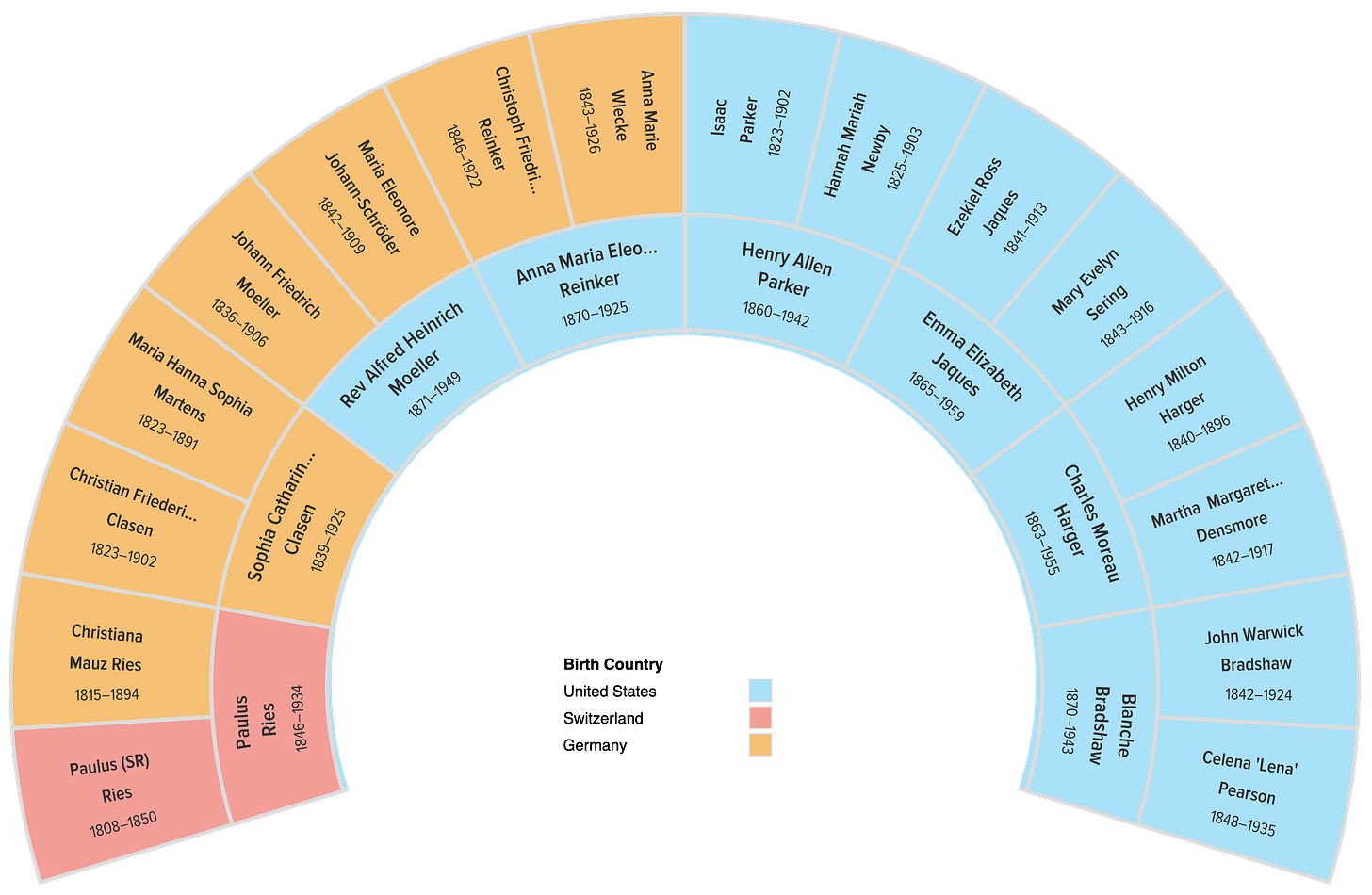
With so many of you here on Substack who share my colonial American ancestry, finding a few distant cousins was a pretty straightforward path. Hey there cousins
, , , and (to name a few.)These connections were relatively easy because my grandmother and great-grandmother's work documented my maternal ancestors. Her book, Harger and Allied Families, is available on the Internet Archive and widely referenced on the FamilySearch platform. At some level, though, I hoped the post might help me find cousins with notes on my paternal line. I didn’t expect anything would come of it.
The Ries Family in America
Seven months later, a new subscriber,
dropped a comment introducing himself as a cousin. He had found me through a search for names, specifically landing on “Paulus Ries (1808-1851),” my second great-grandfather.We were just one generation apart. His second great-grandmother, Anna Maria Ries (1833-1893), was a big sister to my great-grandfather, Paul Ries (1846-1934). We’d been brought together by a traumatic story of family loss (and a smidgeon of SEO).
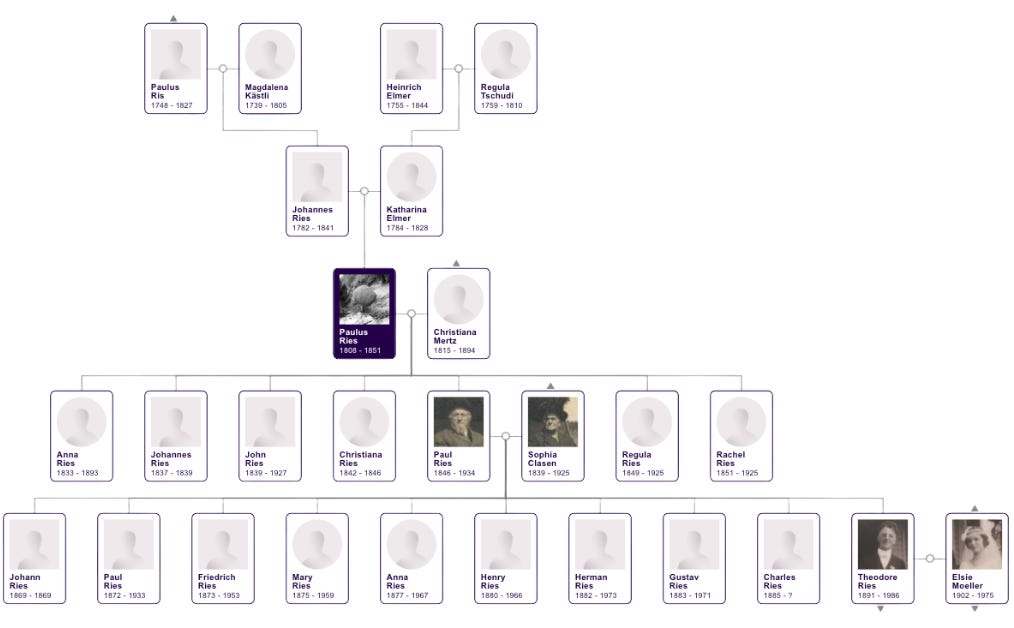
Joel knew the name from family lore. Paulus Ries (Sr.) was his third great-grandfather. He had heard the same story about how our family came to America after the patriarch was killed by a “rolling ball of hay.” In 1853, Paulus Ries’ widow, Christiana Ries (Mertz2), came to America with her children.
After exchanging DMs, Joel and I connected over Zoom. We shared stories for over two hours that Sunday afternoon. In a follow-up email, he shared documents, photos, and a family tree3 relating to our shared history in German-speaking communities in Minnesota, Wisconsin, and Michigan.
I’d found my father’s family, 172 years after they settled in America.
When the elder Paulus Ries died in Switzerland in 1851, he was a young man in his early forties with five children. His youngest daughter, Rachel, was still an infant. Paulus’ widowed mother-in-law, Anna, probably also lived with the family.
Two years later, his widow, mother-in-law, and five living children left the Alps for America.
Why and how did they emigrate? How does someone get crushed by a rolling ball of hay? Does hay even roll? I had so many questions.
After our meeting, I wanted to contribute to the incredible family history work Joel had so generously shared. I committed to finding answers to those questions.
This is where the story took me on an SEO4 ride—again. I was confident that Linthal, Glarus, Switzerland, was our ancestral home. Instead of focusing on the name, I honed in on the town. That was the key.
A Rolling Ball of Hay
With this new framing, I quickly landed on a website for Glarus Family Tree (GlarusFamilyTree.com). That WAS embarrassingly obvious.
If the title wasn’t enough, the description made me feel like I’d stepped into some master plan. It was a partial quote from the Storyteller’s poem, variously attributed to Della M. Cummings Wright5. I was meant to find this.
“We are the chosen ones. In each family there is one who seems called to find the ancestors, to put flesh on their bones and make them live again, to tell the family story and to feel that somehow, they know and approve. To me, doing genealogy is not a cold gathering of facts but, instead, breathing life into…”
Within minutes of discovering the website, I’d answered the first question about what would cause a ball of hay to roll: Gravity. Okay, Captain Obvious, I get it.
The “Worth Knowing” pages on the Glarus Family Tree site explained that cultivating hay in the Swiss mountains was perilous. It required the skilled labor of a wildheuer (wild-hay cutter). These men would climb to the high-mountain pastures where cattle could not graze to cultivate the hay for their animals in the valleys below. (Get some perspective on this harrowing task in the clip below from an incredible, undated silent film on YouTube.)
We later learned that Paulus wasn’t a “Wildheuer” but a master cooper or “Küfermeister.” I can’t imagine he directly encountered the hay ball while knocking wood into bands to make kegs. However, I suppose the same skills might be helpful in repairing the wooden sledges that bring hay down from the high Alps.
The detailed descriptions and lavish illustrations of the Glarus Family Tree site captivated me. I responded to the contact email. The next morning, I received a remarkable reply email from the site owner, Patrick Wild.
Through the Tunnel to Switzerland
Patrick’s reply welcomed me as a cousin. He had an extensive report ready for me as a member of the Ries and related families. He and a string of dedicated collaborators have compiled and preserved these records for over a century.
The remarkable Glarus canton has survived waves of history. Today, with just 41,000 residents, it houses a treasure trove of genealogical data. In the 19th century, a civil servant, Johann Jakob Kubly-Müller (1850-1933), started a project in retirement to transcribe and structure all parish records for the benefit of future genealogists. From 1893 to 1928, his entries meticulously captured birth, death, marriage, and other life events in dozens of handwritten volumes.
These records are now housed at the Glarus Canton archive in a special area for this genealogy work. My correspondent, Patrick Wild, has taken it upon himself to continue Johann Jakob Kubly-Müller’s work by digitizing his records and expanding them into modern databases that can be readily searched for the benefit of descendants of emigrants worldwide. As Patrick explains in an introduction to his database at Geneanet.org,
“I have been dealing with the families from Glarus for many years and I am mainly looking for the descendants of the emigrants from Glarus who left the country in the middle of the 19th century until the beginning of the 20th century. Due to this research of many years I could build up a database with more than 360'000 persons… I have created a Glarus family tree that goes back to the beginnings of church records in the canton of Glarus, as something as far back as the 16th century.”
It was as if he’d been waiting for me. He even had the answer to my simple question about my second great-grandfather’s demise. According to the register, in August 1851, Paulus Ries had been
“hit by a bundle of hay, broke his spine and died the following day.”
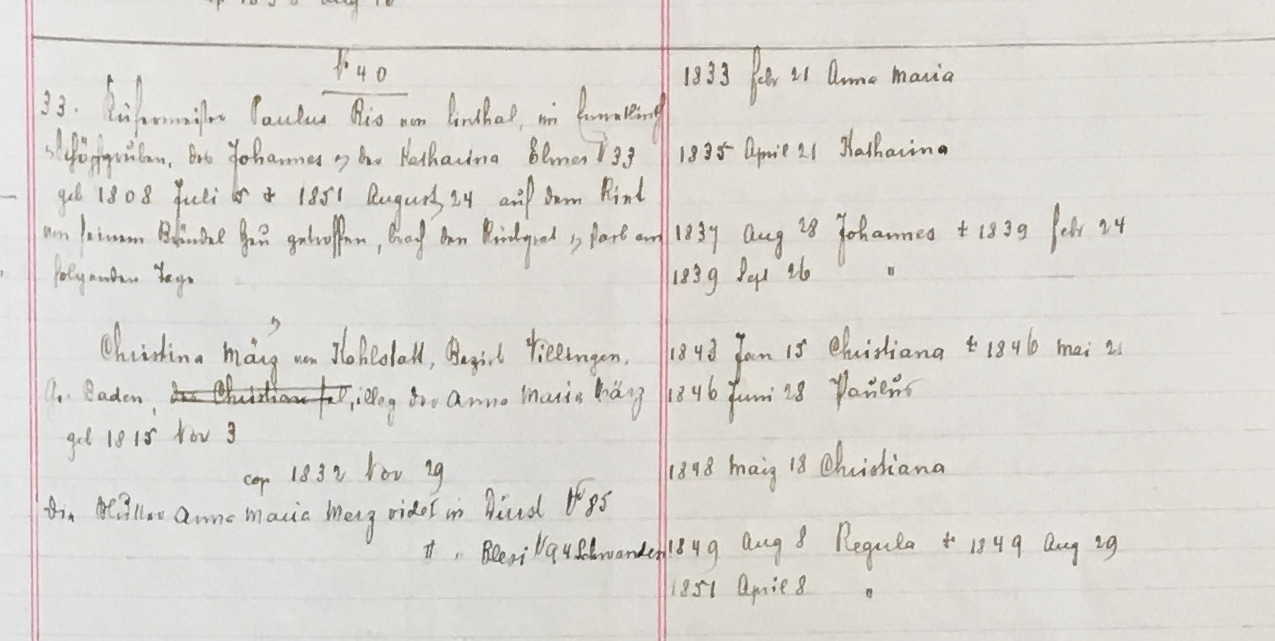
From his databases, Patrick was gracious enough to provide me with an Ancestry report dating back 15 generations to the 16th century. He additionally included Descendancy report for Paulus Ris (1808-1851) that captures what he’d learned about our American cousins over the years. On Patrick’s Geneanet.org pages, you can explore the Ris family starting with Daniel Ris (b. ~1560), or any of the Glarus allied families, including over 365K individuals on Patrick’s family trees. Patrick also maintains a public tree on Ancestry, “Glarus Family Tree,” (currently dated 2025 August.)
This is an incredible object lesson in what genealogists can do when they collaborate in an ordered way across generations.
Sometimes you have to be ready to find what you’re looking for before you can find it.6 I wasn’t entirely wrong to look for the name “Ries,” as explained in the Geneanet.org pages:
RIS or Ries, an old, reformed council family in Linthal and Glarus. Its name is apparently derived from the upper name Riese
Since Daniel Ris was born around 1560, Swiss records have captured the name in our family line without the “e.” It’s a reminder to review linguistic differences and various spellings for a name.
Coated in Arms
It’s easy for Americans to get excited to see a family coat of arms. We don’t have such nice things; these drip with European elegance.
As a practical matter, though, I also found them helpful to sort through the origin of our name. Our American family branch had passed down a woodblock print of our supposed Ries family crest with what looks like a date of 1437. Both Joel and I had the same crest, though his included this statement:
This family crest has been researched only to the extent that it was given to Peter Alphonse Ries in 14377, and his descendants immigrated to the United States. Until we can trace our lineage back to Peter, we cannot be sure that we belong to that particular branch of the Ries family.8
The two crests on the right appear consistent, regardless of the spelling. Three crows or birds in the crest. Perhaps a bird at the top, a knight’s helmet. On the far left, it’s all about the griffin. One in the back and one on a shield.
I may not have the language of heraldry, but I can say that one of these is not like the other.
The one on the far right was copied from family history references shared in photocopies.
The one in the middle was copied from Patrick’s Geneanet.org pages. It appears to reference “Wappenbuch des Landes Glarus,” 1937, by Ida Tschudi-Schümperlin and Jakob Winteler.
The one on the right was captured from Samuel Wild's “Coats of Arms of the Citizen Families of the Canton of Glarus,” dated 1902, and captured on the site for the State Archives of the Canton of Glarus.
I have to conclude that the one on the left is likely for another family.
Finding the Immigration Story
I find myself wondering about Christiana’s journey.
What route did Paulus Ries’ widow, Christiana Mertz (or Merz) Ries, take with her mother and five young children?
Why and when was the name changed so explicitly from Ris to Ries?
Did they depart Europe from the French port of Le Havre like so many others from Glarus?9
Where did the family initially settle, and why there?
What specifically inspired Christiana to risk the journey?
Joel Gerich discovered a tantalizing hint left in 2007 by “Linda Ries” on a Genealogy.com forum. It was titled “Christiana Ries 1853” and described a trunk of 4 x 2 x 2 ft with her name and that date stenciled on it. She described having seen and purchased it at an antique market in Illinois. There are no further posts about it. I’d love to find this trunk and connect with Linda. Perhaps she is also a cousin.
Next steps
With this new wealth of resources, I’m moved to reflect on the beginning of this brief journey. The magic of SEO connected me with two remarkable genealogists from opposite sides of the planet. These cousins introduced me to intriguing chapters of our shared family and their insights as skilled genealogists. Joel has artifacts, locations, and living memories. Patrick has direct access to this ancestral home, centuries-old documents, and an eagerness to explore the overseas stories of our shared family members.
Candidly, I’m still a little stunned.
I’ve long anticipated “heritage travel” to learn about my maternal family roots across the American mainland and Britain. I’d never given much thought to my Swiss family roots. This completely reorients my map toward Switzerland.
I look forward to forming a team with my new cousins to explore these mysteries together.
I expect a few new projects to result. Stay tuned.
Substack’s SEO is so good that you can search the web for “Substack.com: ‘My Sixteen’” to find posts that specifically used that reference to “My Sixteen.” On Monday, 21 July 2025, I wrote a post for my sister publication at MissionGenealogy offering tips on using Substack’s SEO. You’ll find it here:
If you are interested, Joel Gerich’s meticulously documented family tree is archived as the public Gerich Family Tree on Ancestry.com (You can view it through the free library edition here).
SEO stands for Search Engine Optimization. To thank modern SEO for this remarkable coincidence, I wrote a tip for MissionGenealogy about making the best use of Substack's SEO features.
It’s remarkable to see how many times this poem has been quoted by genealogists referencing either “anonymous” or Della M. Cummings Wright and her family. More about that in “The mysterious origins of that genealogy poem,” by Linda Yip Genealogy.
I should have anticipated a name change. Though I don’t quite have a clear sense of the difference in cases, it’s clear that in the case of our ancestors, the Swiss Ris becomes Ries in the American records. Other families with this name preceded the family’s arrival; perhaps it was applied at immigration.
I have no specific reference on where and when this happened. All I have is, “Peter Alphonse Ries in 1437.” I’ve not been able to find any reference to who this was. There’s a Pierre Alphonse Ries with a 1911 birth record from Luxembourg on FamilySearch, and a Peter Alphonse Riess with 1871 death record from Thann-Guebwiller, France on Ancestry’s library edition.
Searches have turned up little more than old Reddit chatter and perhaps a resemblance to the crest for the German mathematician Adam Ries (1492-1559). My guess is that it was a German crest, not related directly to our family.
Patrick Wild’s research suggests many Glarus emigrants traveled to America through Le Havre. See “Le Havre: The emigration harbor that fulfilled the dreams of the Glarus emigrants to New York.”






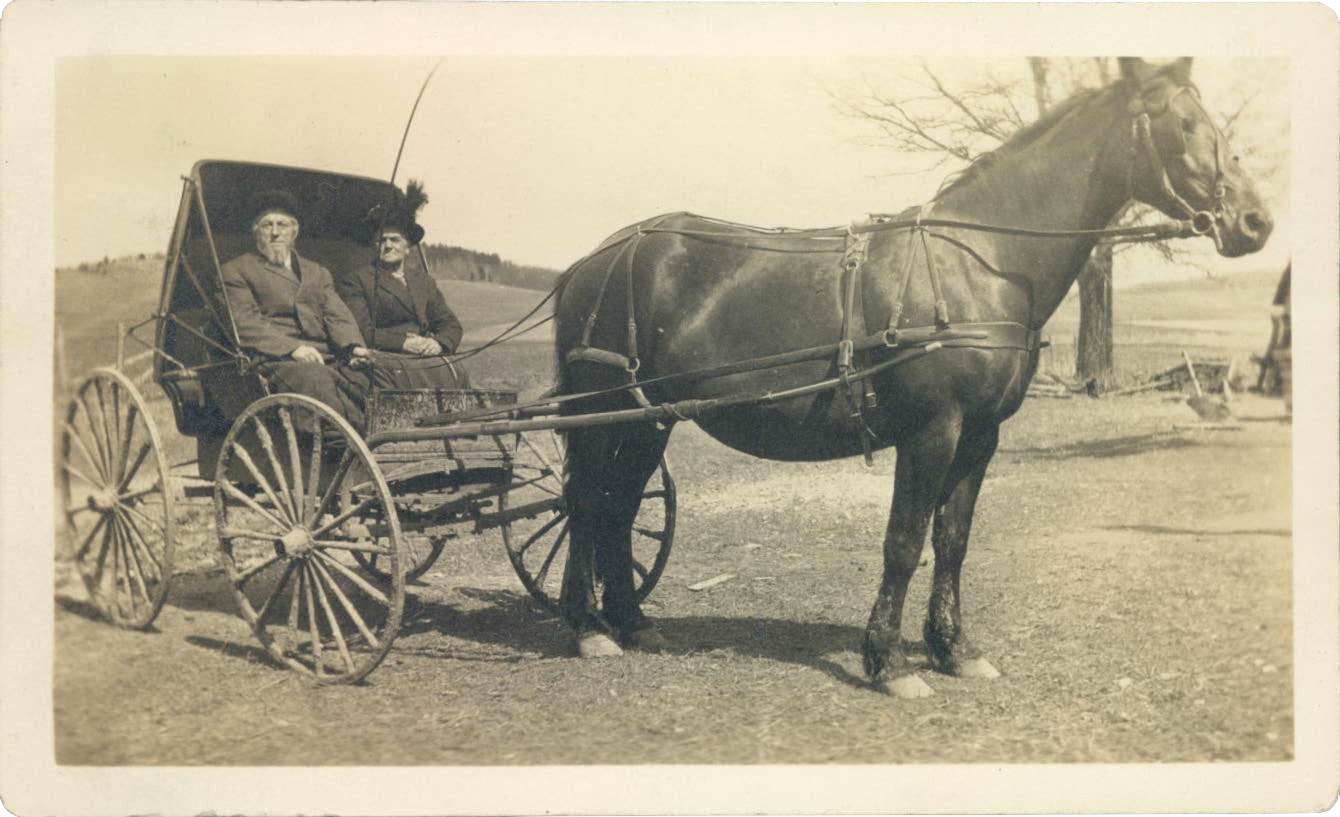
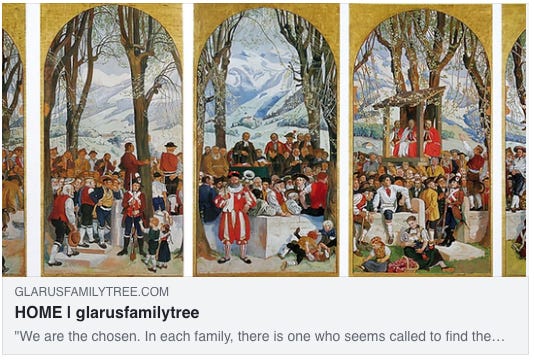





It’s been great to make the connection with you, cousin Barbara, and share Paulus’ story with a wider audience. His story is so interesting, yet not so different from so many other immigrant families in the 1800s. Thanks for getting this out there. Now if only one of the many Ries cousins can lead us to Christiana’s immigration trunk!
Great that you were able to find evidence to corroborate the rolling hay story and learn so much in the process. It's great when distant relatives make contact and want to share what they know and collaborate in making new discoveries.